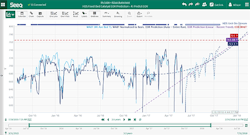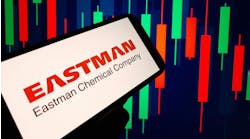The attention chemical makers are giving to sustainability often now extends along their entire supply chain. Indeed, some manufacturers are working hard to ensure their suppliers meet specified sustainability standards.
Clariant, Muttenz, Switzerland, is a case in point. The company has about 20,000 active suppliers, roughly 8,000 providing raw materials, with the rest responsible for everything from catering to energy to packaging. To keep track of suppliers’ efforts, the company uses the Together for Sustainability (TfS) standard. This joint initiative of 31 chemical companies provides a de facto global standard for environmental, social and governance performance of chemical supply chains. The United Nations Global Compact and Responsible Care principles underpin the TfS program, which EcoVadis, Paris, a business sustainability ratings provider, manages.
“The benefit of TfS is that a company may be a small supplier to us but a larger supplier to one of the other TfS members. Suppliers only need to fill out one self-assessment, that is then published in a central database. We work hand-in-hand with our suppliers across the world to make sure they understand the process on the EcoVadis platform,” explains Markus Mirgeler, Clariant’s head of group procurement services.
“It’s available in all regions and all our buyers are involved in the process, which is quite intensive and involves training and teaching internally for us also. I would say a good 15–20% of our buyers’ jobs is to manage sustainability with their suppliers, including a large focus on greenhouse gas emissions [GHGs], showing that the job of a buyer has certainly changed,” he adds.
Issues inevitably do arise with suppliers. These matters can be quite diverse. For instance, Mirgeler cites the case of an employee who noticed a child-sized footprint on a pallet. With concerns raised about possible child labor, Clariant within 48 hours made an unannounced visit and discovered that children were playing at the back of the plant near dangerous chemicals. A re-inspection a month later found a proper safety fence in place and correct storage of dangerous chemicals.
In another example, a Clariant inspector called Mirgeler with a recommendation to stop working with a supplier immediately. “So, we discussed with the business unit how important that converter was and what our options were. In the end, we prepared an action plan with a timeline for improvements and in six months this company turned itself around with our help and because our business was important to them.”
Meanwhile the company has been discussing GHG reductions with other TfS members, pondering, for example, whether suppliers could be asked to include a product carbon dioxide value on every invoice.
Mirgeler also points to a new Supply Chain Act due in Germany in 2023 that will oblige German companies to ensure their suppliers from abroad comply with environmental and social standards. “In my view, it will very quickly become European law, with a huge impact on businesses,” he believes.
European System
SABIC, Geleen, The Netherlands, which consistently is rated among the top 1% performers of the chemical and fertilizer companies evaluated by EcoVadis, has been working with industry stakeholders to develop robust criteria for sustainability assessment in the Safety & Quality Assessment for Sustainability (SQAS) system, www.sqas.org. This system, managed by the European Chemical Industry Council (Cefic), Brussels, relies on uniform third-party assessments to evaluate the performance of logistics service providers (LSPs) and chemical distributors. SQAS assessments cover quality, safety, security, environment and corporate social responsibility (CSR).
“The SQAS reports provide a good insight in the strengths and weaknesses of current and potential service providers. Chemical companies use the assessment reports in their selection processes of new service providers and for the ongoing evaluation of the standards and performance of their existing service providers,” notes Frank Kuijpers, SABIC’s general manager corporate sustainability.
To benchmark their performance against assessed peers, LSPs follow a number of steps, including evaluating their own systems and performance against a company questionnaire and undergoing assessment by an expert trained and accredited by Cefic.
Figure 1. European initiative to prevent pellet, flake or powder loss particularly focuses on logistics service providers. Source: SABIC.
SABIC downloads and analyzes the assessment reports of its logistics suppliers in the tendering-phase or when the supplier is re-assessed.
SABIC also is involved in another initiative — operation clean sweep (OCS) Europe. Here, the company is helping create a certification scheme that will apply to LSPs that works towards zero pellet, flake and powder loss. A 2022 version of SQAS will implement the OCS developments.
According to Kuijpers, the main challenge is to cascade — throughout the entire logistics chain — the importance of zero spill of plastics (Figure 1).
“For a long time, the focus of logistics safety has been on dangerous goods. As a consequence, the operators that deal with dangerous goods have been the focus of technical and behavioral training. Many key companies in the supply chain have fully internalized the concepts of OCS, but this is not yet true for all. So leveraging them all is the challenge for OCS,” he stresses.
SABIC also has updated its supplier code to more clearly and transparently reflect its current business, environment and regulatory requirements. Hand-in-hand with this is its supplier lifecycle management (SLM) program that reviews existing suppliers against the actual business they provide. SABIC will assign training to certain suppliers lacking in certain compliance processes or procedures. However, SLM led SABIC to remove 357 companies in 2020 from its suppliers’ database for business and compliance-related reasons.
Another Metric
Chemours, Wilmington, Del., measures supplier sustainability performance through its supplier corporate responsibility assessment (SCRA), conducted in partnership with EcoVadis.
The SCRA evaluates the effectiveness of a supplier’s environmental, social and governance (ESG) management system across four categories: ethical business practices, social performance, environmental performance, and sustainable supply chain. At the end of the assessment, the supplier receives a scorecard as well as specific recommendations for improving its ESG performance.
“In addition, we are exploring the use of on-site supplier sustainability audits as part of our supplier sustainability evaluations. The combination of supplier assessments with audit capability will help us better understand supplier performance and opportunities to partner with suppliers for meaningful improvements,” explains Michelle Moore, vice president and chief procurement officer.
By the end of last year, the suppliers participating in the SCRA accounted for 59% of Chemours’ spending. The company aims to reach 80% — the top 500 suppliers by spend — in 2030 by training its buyers in how to engage suppliers to increase SCRA participation, discuss assessment results, and set improvement objectives. “This focus will help the organization understand the insights provided by the assessment and how to use the assessments to drive meaningful improvement,” Moore adds.
Another goal for 2030 is to improve supplier sustainability performance by 15%, partly driven by newly implemented supplier sustainability awards.
Easier Data Collecting
Chemical supply chains have been forced to become both localized and transparent in the face of heightened sustainability targets and global trade interruptions which have been further exacerbated by the Covid-19 pandemic, says Allison Buenemann, industry principal – chemicals, Seeq, Seattle, Wash. So data are flowing much more freely between supplier and consumer.
“Some of the challenges of these new agile, local supply chains include ensuring access to live operating data for both vendors and suppliers, while providing sufficient tools to analyze and respond to supply chain modifications or disruptions,” she explains.
For Seeq, this means building connectors to a variety of different source databases. This ensures easy access and analysis from a single application by those closest to the process no matter where the manufacturer and supplier data are stored.
As an example, she cites a chemical customer that switched from an overseas supplier to a local one, only to find the new supplier’s quality specifications included a wider range of feed composition. Using Seeq, the chemical company’s subject matter experts analyzed many years of historical data to better understand the relationships between feed composition, process operating parameters, and finished product quality. “Visibility into the vendor data for incoming feedstocks helped them make proactive process adjustments to maintain product quality,” Buenemann stresses.
Seeq’s ability to directly access source data — with appropriate permissions — also does away with the long timeline and hefty price tags associated with many data consolidation and management projects, she adds.
This allowed one petrochemical customer, for example, to analyze process and laboratory data from its production process with certificate-of-analysis data from its catalyst and raw material suppliers, along with machinery monitoring data.
“High-performance connectors to each source data system provide end users with near-real-time access to all data and take care of data alignment issues — such as timestamp mismatch, time zone conversion, and daylight savings — all behind the scenes,” notes Buenemann.
So, time delays can be applied to the supplier signal data to track and analyze the performance of a shipment of raw material as it moves through the various stages of the production process. These calculated signals automatically scale across time as users examine different periods; they update in near-real-time as new data are recorded.
Figure 2. Impurities vary among suppliers and this can affect catalyst degradation rates. Source: Seeq.
“The one-stop-shop provided by Seeq’s advanced analytics applications gave this company a unique look into the impact that different feed impurities were having on product quality, equipment status, and catalyst degradation rates,” she says (Figure 2).
Automation Integration
Connecting players along the supply chain is one of the key chemical industry initiatives that Yokogawa Electric, Tokyo, is pursuing.
“Many of the sustainability issues we face cannot be solved within a single industry, and that is where companies like Yokogawa can help by conceptualizing and developing horizontal and vertical supply chain networks. This will require us to enhance our ability to become an integrator of holistic solutions,” notes Koichi Nakajima, general manager, major accounts, at the energy and sustainability business headquarters.
In fact, at many of the company’s projects, a majority of components and equipment come from other vendors — making open architectures such as NAMUR that aggregate and process big data volumes ever more important. (For an example of a project involving integration of disparate control systems, see: “Plant Pioneers Use of Automation Concept.”)
“This is not just an IT [information technology] matter, either, because it takes extensive domain experience to identify the relevant data and [their] importance, and to add context. Connected to this point, we are seeing the need for greater convergence with other types of industries, such as robotics, and IoT [Internet of Things] infrastructure,” adds Nakajima.
Figure 3. Manfacturer kept customers well informed about delivery status during COVID-19. Source: Endress+Hauser.
As the need to integrate siloed and geographically separated data sets increases, security also is becoming more important. This not only requires new technologies but also the ability to develop secure work processes and ensure they are understood and implemented by the workforce, he emphasizes.
This is part of the drive behind the company’s big push into edge systems to enable smart manufacturing and its work with numerous IT vendors to develop and roll out next generation cloud infrastructure, along with multiple software-as-a-service applications.
A Powerful Pair
Endress+Hauser, Reinach, Switzerland, has embraced the EcoVadis platform, responding to similar moves by its larger chemical industry customers from custom supplier assessment frameworks to that platform.
“The great advantage of a formal assessment method is that it provides an opportunity to have end-to-end CSR [corporate social responsibility] targets. Through such a process, we better understand our customers’ CSR priorities and targets and, in turn, we are able not only to live up to our standards but also contribute to their EcoVadis results,” explains Michael Sinz, director strategic business.
The company also is taking part in the TfS initiative. “The TfS member companies and Endress+Hauser collaboratively agree on site factory audits executed by independent third parties. The resulting corrective actions plans are documented and shared with all TfS member companies,” adds Sinz.
The combination of EcoVadis assessments and TfS audits are the most suitable tools to continuously align customer and supplier expectations, he feels.
Meanwhile, the Covid-19 pandemic has increased the CSR requirements on both customers and suppliers. “A holistic and transparent CSR policy is a must in [the] future. It will be a competitive advantage and a differentiator,” stresses Philip Conen, global industry manager chemical.
Endress+Hauser IT experts worked closely with its staff who had to work from home to ensure no interruptions of connections with chemical customers. At the same time, its production centers (Figure 3) also kept customers current on the delivery status of equipment.
“In this way we both protected our employees — the number one priority — and maintained trust with our customers,” concludes Conen.
Seán Ottewell is Chemical Processing's editor at large. You can email him at [email protected].






